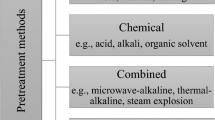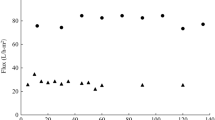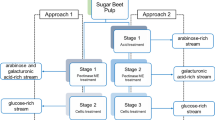Abstract
Sugar beet pulp (SBP) is a carbohydrate-rich residue of table sugar processing. It shows promise as a feedstock for fermentable sugar and biofuel production via enzymatic hydrolysis and microbial fermentation. This research focused on the enzymatic hydrolysis of SBP and examined the effects of solid loading (2–10 %, dry basis), enzyme preparation, and enzyme recycle on the production of fermentable sugars. The enzyme partitioning to the solid and liquid phases during SBP enzymatic hydrolysis and loss during recycling were investigated using SDS-PAGE and Zymogram analysis. Without considering product inhibition, the cellulase added initially to the SBP hydrolysis lost only 6 % filter paper activity and negligible carboxymethyl cellulose activity upon multiple cycles of SBP hydrolysis. It was found that enzyme dosage can be reduced by 50 % while maintaining similar, and in some cases higher fermentable sugar yield. The removal of hydrolysis products will further improve enzymatic hydrolysis of SBP for biofuel production.









Similar content being viewed by others
References
Agarwal AK (2007) Biofuels (alcohols and biodiesel) applications as fuels for internal combustion engines. Prog Energy Combust Sci 33:233–271
Foster BL, Dale BE, Doran-Peterson JB (2001) Enzymatic hydrolysis of ammonia-treated sugar beet pulp. Appl Biochem Biotechnol 91–93:269–282
Doran JB, Caripe J, Sutton M, Foster B (2000) Fermentations of pectin-rich biomass with recombinant bacteria to produce fuel ethanol. Appl Biochem Biotechnol 84–86:141–152
Rorick RE, Nabar N, Pryor S (2009) Enzymatic hydrolysis and fermentation of sugar beet pulp. Paper No. 096193. Reno, Nevada
Schaffeld G, Illanes A, Mejías G, Pinochet AM (1987) Sequential acid and enzymatic hydrolysis of sugar beet pulp. J Chem Tech Biotechnol 39:161–171
Micard V, Renard C, Thibault JF (1997) Influence of pretreatments on enzymic degradation of a cellulose-rich residue from sugar-beet pulp. Food Sci Technol-Leb 30:284–291
Spagnuolo M, Crecchio C, Pizzigallo MDR, Ruggiero P (1997) Synergistic effects of cellulolytic and pectinolytic enzymes in degrading sugar beet pulp. Bioresour Technol 60:215–222
Ali LS, Cochet N, Ghose TK, Lebeault JM (1984) Enzymatic hydrolysis of sugar beet pulp. Biotechnol Lett 6:723–728
Yang B, Wyman CE (2006) BSA treatment to enhance enzymatic hydrolysis of cellulose in lignin containing substrates. Biotechnol Bioeng 94:611–617
AOAC (Association of Official Analytical Chemist) (1990) Official methods of analysis, Association of Official Analytical Chemists, 15th edn. AOAC Press, Gaithersburg
Goering HK, Van Soest PJ (1970). Forage fiber analyses (apparatus, reagents, procedures and some applications). Agriculture handbook no. 379. USDA-ARS, Washington DC
Ahmed AER, Labavitch JM (1977) A simplified method for accurate determination of cell wall uronide content. J Food Biochem 1:361–365
Melton LD, Smith BG (2001) Determination of the uronic acid content of plant cell walls using a colorimetric assay. Current protocols in food analytical chemistry E3.3.1–E3.3.4
Miller GL (1959) Use of dinitrosalicylic acid reagent for determination of reducing sugar. Anal Chem 31:426–428
Ghose TK (1987) Measurement of cellulase activities. Pure Appl Chem 59:257–268
Smith J (2004) Mixed β-glucanase, xylanase from Humicola insolens. ftp://ftp.fao.org/es/esn/jecfa/cta/CTA_61_mixedgluconase.pdf. Accessed 7 Oct 2011
Bailey MJ, Pessa E (1990) Strain and process for production of polygalacturonase. Enzyme Microb Technol 12:266–271
Dalal S, Sharma A, Gupta MN (2007) A multipurpose immobilized biocatalyst with pectinase, xylanase and cellulase activities. Chem Cent J 1:16
Philippidis GP, Smith TK, Wyman CE (1993) Study of the enzymatic hydrolysis of cellulose for production of fuel ethanol by the simultaneous saccharification and fermentation process. Biotechnol Bioeng 41:846–853
Pryor SW, Rorick RE, Nahar N (2008) Enzymatic hydrolysis of sugarbeet pulp for cellulose isolation and ethanol production. http://www.sbreb.org/research/prod/prod08/Enzymatic.pdf. Accessed 7 Oct 2011
Michel F, Thibault J-F, Barry JL (1988) Preparation and characterisation of dietary fibre from sugar beet pulp. J Sci Food Agric 42:77–85
Micard V, Renard CMGC, Thibault JF (1996) Enzymatic saccharification of sugar-beet pulp. Enzyme Microb Technol 19:162–170
Spagnuolo M, Crecchio C, Pizzigallo MDR, Ruggiero P (1999) Fractionation of sugar beet pulp into pectin, cellulose, and arabinose by arabinases combined with ultrafiltration. Biotechnol Bioeng 64:685–691
Acknowledgments
The funding for this research was provided by Chevron Technology Ventures.
Author information
Authors and Affiliations
Corresponding author
Rights and permissions
About this article
Cite this article
Zheng, Y., Cheng, YS., Yu, C. et al. Improving the efficiency of enzyme utilization for sugar beet pulp hydrolysis. Bioprocess Biosyst Eng 35, 1531–1539 (2012). https://doi.org/10.1007/s00449-012-0743-z
Received:
Accepted:
Published:
Issue Date:
DOI: https://doi.org/10.1007/s00449-012-0743-z




